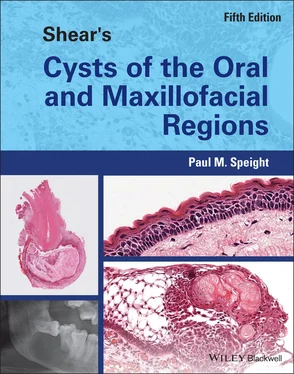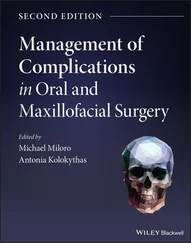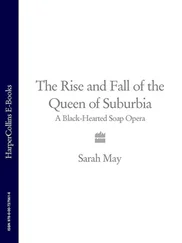Paul M. Speight - Shear's Cysts of the Oral and Maxillofacial Regions
Здесь есть возможность читать онлайн «Paul M. Speight - Shear's Cysts of the Oral and Maxillofacial Regions» — ознакомительный отрывок электронной книги совершенно бесплатно, а после прочтения отрывка купить полную версию. В некоторых случаях можно слушать аудио, скачать через торрент в формате fb2 и присутствует краткое содержание. Жанр: unrecognised, на английском языке. Описание произведения, (предисловие) а так же отзывы посетителей доступны на портале библиотеки ЛибКат.
- Название:Shear's Cysts of the Oral and Maxillofacial Regions
- Автор:
- Жанр:
- Год:неизвестен
- ISBN:нет данных
- Рейтинг книги:5 / 5. Голосов: 1
-
Избранное:Добавить в избранное
- Отзывы:
-
Ваша оценка:
- 100
- 1
- 2
- 3
- 4
- 5
Shear's Cysts of the Oral and Maxillofacial Regions: краткое содержание, описание и аннотация
Предлагаем к чтению аннотацию, описание, краткое содержание или предисловие (зависит от того, что написал сам автор книги «Shear's Cysts of the Oral and Maxillofacial Regions»). Если вы не нашли необходимую информацию о книге — напишите в комментариях, мы постараемся отыскать её.
Shear’s Cysts of the Oral and Maxillofacial Regions
Shear’s Cysts of the Oral and Maxillofacial Regions Fifth Edition
Shear's Cysts of the Oral and Maxillofacial Regions — читать онлайн ознакомительный отрывок
Ниже представлен текст книги, разбитый по страницам. Система сохранения места последней прочитанной страницы, позволяет с удобством читать онлайн бесплатно книгу «Shear's Cysts of the Oral and Maxillofacial Regions», без необходимости каждый раз заново искать на чём Вы остановились. Поставьте закладку, и сможете в любой момент перейти на страницу, на которой закончили чтение.
Интервал:
Закладка:
Molecular studies have provided much useful and interesting information relating to the pathogenesis of odontogenic lesions, especially with regard to the role of the PTCH gene in the odontogenic keratocyst and to the role of the SHH (hedgehog), WNT, and MAPK signalling pathways in a variety of cysts and tumours (Diniz et al. 2017 ; Bilodeau and Seethala 2019 ). Molecular tests, however, have not yet proven to be useful in routine diagnosis of cysts. The main exception to this is the identification of MAML2 rearrangements that can be helpful in differentiating between the glandular odontogenic cyst and intraosseous mucoepidermoid carcinoma (discussed in Chapter 10). Table 2.4summarises a number of molecular techniques that may show some value as diagnostic markers.
Table 2.4 Immunohistochemical and molecular markers that might have diagnostic utility in the differential diagnosis of cysts.
| Immunohistochemistry | ||
|---|---|---|
| Antibody | Target | Diagnostic utility |
| CK10 | Type I keratin, found mainly in cornified epithelia | CK10 stains keratinising epithelium and is positive in the superficial layers of odontogenic keratocyst and orthokeratinised odontogenic cyst. Of little value in histological sections, but has some utility in cytological smears from aspiration biopsies. Cells from keratocyst and orthokeratinised odontogenic cyst are positive, but dentigerous cysts and ameloblastomas are negative (August et al. 2000 ). Pan‐cytokeratin antibodies (AE1/AE3) may also stain keratin in smears from inflamed cysts (Vargas et al. 2007 ) (Figure 7.22) |
| CK18 and CK19 | Keratin intermediate filaments. Both are widely expressed, but CK19 is seen typically in odontogenic epithelium | Use of both antibodies together has been shown to be useful to distinguish a glandular odontogenic cyst from central mucoepidermoid carcinoma (Pires et al. 2004 ; discussed in Chapter 10). Glandular odontogenic cyst is CK19+/CK18‐. Mucoepidermoid carcinoma is CK19‐/CK18+ |
| Calretinin | Calretinin, a widely expressed calcium‐binding protein | Calretinin has been shown to be positive in up to 100% of ameloblastomas, including unicystic ameloblastoma. Odontogenic cysts including keratocysts are negative. Useful to differentiate cystic ameloblastoma from other cysts, especially in small biopsies from the posterior mandible region (Altini et al. 2000 ; Coleman et al. 2001 ; De Villiers et al. 2008; Jeyaraj 2019 ; Rudraraju et al. 2019 ; discussed in Chapters 5and 7) |
| Maspin | Maspin, a member of the serine protease inhibitor superfamily | May be useful in the differentiation of glandular odontogenic cyst from central mucoepidermoid carcinoma, especially in small biopsies where not all features may be apparent. Maspin is widely expressed, but studies have shown much greater expression in the mucous cells of mucoepidermoid carcinoma than in glandular odontogenic cyst. Note that the differences relate only to mucous cells – other epithelial cells of the cyst lining are positive (Vered et al. 2010 ; Chapter 10, Table 10.4) |
| β‐catenin | Cell surface protein important in cell adhesion, but also in the regulation of the WNT signalling pathway | Intracellular expression of β‐catenin (cytoplasmic and nuclear) is characteristic of calcifying odontogenic cyst (and other ghost cell lesions – see CTNNB1 gene below) and is seen in all cases. However, it is not diagnostic, since it may also be seen in ameloblastomas |
| p16 | p16 is a cyclin‐dependent kinase inhibitor, involved in regulation of the cell cycle | p16 antibodies are useful in the differentiation of branchial cleft cyst from a cystic metastasis in the lateral neck. p16 is activated by human papillomavirus (HPV) infection and strong expression, interpreted in context, is almost diagnostic of HPV‐associated oropharyngeal carcinoma. The majority of cystic metastases come from HPV‐associated squamous cell carcinomas and are p16 positive, but branchial cysts are negative. Note that positive staining must be carefully interpreted and the correct criteria must be used (Pai et al. 2009 ; Cao et al. 2010 ; Müller et al. 2015 ; Chapter 18, Figure 18.7) |
| Molecular markers | ||
| Gene | Alterations | Diagnostic utility |
| PTCH | Mutations or loss of heterozygosity (LOH) of PTCH gene | Alteration or loss of PTCH gene is seen in up to 80% of odontogenic keratocysts, but is not diagnostic because altered PTCH may be seen in other cyst types. However, biallelic loss of PTCH has been recorded in keratocysts and not in other odontogenic cysts, and this may be diagnostic |
| MAML2 | Rearrangements of MAML2 gene, usually with CRCT1 or 3 | MAML2 rearrangements are seen in mucoepidermoid carcinomas and their presence helps differentiate intraosseous mucoepidermoid carcinoma from glandular odontogenic cyst, which does not show the translocation (Bishop et al. 2014 ) |
| CTNNB1 | Mutations in the CTNNB1 (β‐catenin) gene | CTNNB1 mutations are seen in a wide range of neoplasms, but within the jaws are almost unique to ghost cell lesions (calcifying odontogenic cyst and dentinogenic ghost cell tumour). However, molecular analysis has not been used for diagnostic purposes. CTNNB1 mutation results in aberrant intracellular (cytoplasmic and nuclear) expression of β‐catenin protein (see β‐catenin above) (Gomes et al. 2019 ; Chapter 11) |
3 Radicular Cyst
CHAPTER MENU
Clinical Features Frequency Age Sex Site Clinical PresentationRadicular Cyst Residual Cyst
Radiological Features
Pathogenesis Pathology of Periapical Periodontitis Phase of Initiation Phase of Cyst Formation Growth and Enlargement of the Radicular CystRole of Hydrostatic Pressure Epithelial Proliferation Degradation of the Connective Tissues and Bone Resorption
Histopathology Cellular and Metaplastic Changes Hyaline Bodies Accumulation of Cholesterol Residual Cyst Pocket Cyst (Bay Cyst)
Malignant Change in Radicular Cysts
Treatment
The inflammatory odontogenic cysts arise as a result of epithelial proliferation within an inflammatory focus due to a number of causes. Radicular cyst is the most common inflammatory cyst and arises due to proliferation of epithelial remnants in the periodontal ligament as a result of periapical periodontitis following death and necrosis of the pulp. Radicular cysts are most commonly found at the apex of the involved tooth, but may arise on the lateral aspect of the root in relation to a lateral root canal. Quite often a radicular cyst remains behind in the jaws after removal of the offending tooth and this is referred to as a residual cyst (Speight and Soluk‐Tekkeşin 2022a ).
Inflammatory cysts may also occur on the lateral aspect of a tooth as a consequence of an inflammatory process in pericoronal tissues. This lesion has been referred to as a paradental or inflammatory collateral cyst (Main 1970 ; Craig 1976 ; Speight and Soluk‐Tekkeşin 2022b ). Radicular and residual cysts are considered in this chapter. The inflammatory collateral cysts are considered in Chapter 4.
Clinical Features
Frequency
Radicular and residual cysts are by far the most common cystic lesions of the jaw bones, probably accounting for more than half of all cystic lesions and about 60% of odontogenic cysts. In an analysis of nearly 10 000 radiolucent jaw lesions, Koivisto et al. (2012 ) found that 73% were periapical granulomas or cysts. Of these, 40.4% were granulomas and 33.0% were cysts.
Читать дальшеИнтервал:
Закладка:
Похожие книги на «Shear's Cysts of the Oral and Maxillofacial Regions»
Представляем Вашему вниманию похожие книги на «Shear's Cysts of the Oral and Maxillofacial Regions» списком для выбора. Мы отобрали схожую по названию и смыслу литературу в надежде предоставить читателям больше вариантов отыскать новые, интересные, ещё непрочитанные произведения.
Обсуждение, отзывы о книге «Shear's Cysts of the Oral and Maxillofacial Regions» и просто собственные мнения читателей. Оставьте ваши комментарии, напишите, что Вы думаете о произведении, его смысле или главных героях. Укажите что конкретно понравилось, а что нет, и почему Вы так считаете.












